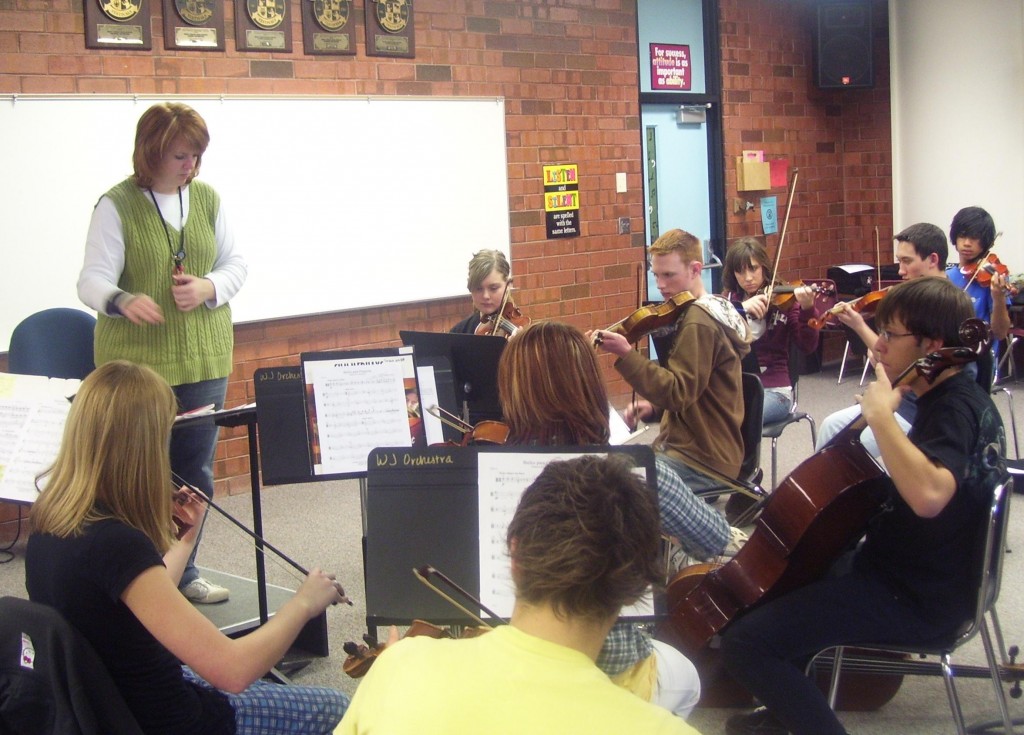Nurturing Healthy Playing Habits in Your Students
In Part 1 we learned about Jenna Baumgart’s personal journey as a musician with a performance injury. Now, she’s back to tell you a bit about the research she conducted for her Master’s thesis, and offer some advice to other music instructors on how to prevent injuries in their students.
Question: Can you tell us a bit about the research you conducted for your Master’s degree? What were your findings?
Here is the abstract to Baumgart’s thesis, to give us an overview of her research:
ABSTRACT
The purpose of this study was to examine teachers’ knowledge of injury prevention in young string musicians and to determine whether teachers who are trained in a body awareness method are more likely to use that method in their classrooms. The author mailed 1353 questionnaires to members of the American String Teachers Association seeking basic demographic information, if the teacher was trained or certified in a Body Awareness Method (BAM) and if the teacher uses a body awareness method in the classroom. Teachers’ opinions regarding the comfort of their students, applying best posture practice for each of the instruments, student seating (type of chair), and instrument fit are asked for. Teachers were asked if they are comfortable addressing the concerns of students who say they are playing with pain, and if the teacher is aware of physicians in their area who deal specifically with prevention, rehabilitation, and treatment of performance injury. Results indicate that, while teachers are concerned about student comfort, few teachers use a BAM in their classrooms, even if they are trained in an awareness method, and most are not aware of local health care practitioners who can help treat and rehabilitate performance injury.
Jenna Baumgart: Even though teachers may have been injured or may be trained in a body awareness method, they do not have a tendency to use the method in class to the benefit of their students. Teachers with this training really need to work body awareness into their rehearsal schedule. No matter how hard we may try, students can be stubborn. They need to buy into what it is you’re selling and some may never adapt to what you’re teaching them.
Question: Do you have any tips for your colleagues on how to address performance injuries in their students? Or how to prevent these injuries?
Jenna Baumgart: There are so many facets to this. Injuries in students can come from poor performance practice, outside sources, and basic heredity. I feel the most important things we can do are: help prevent, gain knowledge, and be an advocate.
1) Help prevent:
- Make sure we know what appropriate posture is for each instrument; for example, if you are a cellist, do you know how a violinist should sit and how their instrument affects the body? And vice versa.
- How can you improve equipment – Do you have chairs that are appropriate height for the student? Would it benefit a shorter student to have a stool for their feet? Do chairs have proper lumbar type support? If not, can you add inexpensive foam to help? Or can you help tilt a chair forward with wood wedges so that the hips are rotated slightly forward, and not leaning back?
- Are instruments too large or too small?
- Lighting – Are students leaning forward or squinting trying to see music? (of course some of this may be that a student has poor eyesight, which is another issue that should be addressed)
These are broad points, but often ones that are able to be remedied by teachers with minimal cost or time investment
2) Gain knowledge
- If you have students complaining of pain, find out why.
- Get off the podium! You can’t see the posture of your student from the podium
- Make observations – are students sitting improperly? Are shoulders and/or backs twisted or hunched as they play? Are students wrapping their legs around the legs of the chair or sitting with their legs crossed or tucked up underneath them?
- Often it’s the simple things that will make the most difference. Trust your gut. If it looks uncomfortable, it probably is!
3) Be an advocate
- If your student becomes injured, ask to help in their rehabilitation. Communication with parent, student AND physician (even if that communication is through the student or parent) is going to be to the benefit of the student musician. Often doctors and therapists do not take into account the physical demands of being a musician. Ask questions such as – Does this posture affect the injury? How soon can the student begin playing again? How much time per practice session should the student be allowing at this stage in their injury?
- Remember – the injury your student is dealing with may not have been caused by playing (softball, football, track, bouncing on the tramp), but playing may be difficult or making the injury worse.
To the Readers: Do you agree with this advice? What have you found helpful with your students? How can we help music students prevent injuries?
Coming up next: “Interview with Jenna Baumgart, Part 3: Staying Healthy with a Busy Lifestyle”. In the final installment of this interview, Baumgart will share her ideas about how to prevent injuries as a performer in today’s busy world, and offer some hopes for the future.















No comments yet.